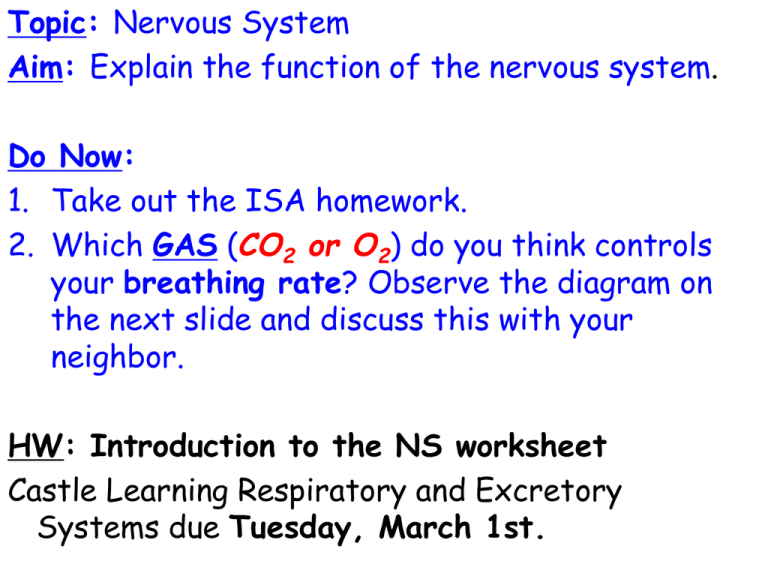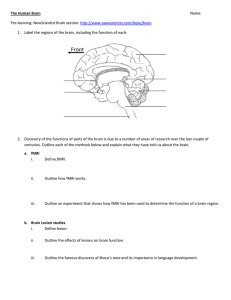Introduction to the NS
advertisement

Topic: Nervous System Aim: Explain the function of the nervous system. Do Now: 1. Take out the ISA homework. 2. Which GAS (CO2 or O2) do you think controls your breathing rate? Observe the diagram on the next slide and discuss this with your neighbor. HW: Introduction to the NS worksheet Castle Learning Respiratory and Excretory Systems due Tuesday, March 1st. Which gas regulates or controls your breathing rate? CO2 1. • Body’s control center Describe • REGULATION the function • Maintains homeostasis of the nervous system. 2. Identify the electrochemical messages in the NS. • Impulses 3. Identify structures that detect changes in the environment. • Receptors 4. Identify • Stimuli the changes in the environment detected by receptors. Identify the stimulus. Support your answer. •The pin Identify the stimulus. Support your answer. •The hammer 5. Identify the sense organs receptors are located in. • Skin, tongue, ears, eyes, nose 7. Identify the different types of receptors. • Mechanoreceptors • Photoreceptors • Thermo-receptors • Pain receptors • Osmoreceptors • Chemoreceptors 4. Which • Touch, pressure, pain stimulus and temperature does the • Mechanoreceptors skin detect? • Thermo-receptors The diagram represents the number temperature receptors in the skin throughout the body. 1. Identify the parts of the body that detect temperature the most? 2. Identify the parts of the body that detect temperature the most? 5. Which stimulus does your tongue detect? • Chemicals in food • Chemoreceptors 6. Which stimulus do your ears detect? • Sound • Mechanoreceptors 7. Which stimulus do your eyes detect? • Light • Photoreceptors Let’s take a look at the structure of the eye. In the dark In the light 8. Which stimulus do your nose detect? • Chemicals in the air • Chemoreceptors What do one eye say to the other eye??????? There is something between us that smells. 9 or 10. What is a response? • A reaction to a stimulus Watch the following video. Identify the response of the ship. http://www.youtube.com/watch?v=qliI4LXdqpQ 8 or 10. Identify the structure that produces a response. • Effectors 9 or 11. • Muscle contracting Identify to move an arm three examples of effectors. • Muscle squeezing saliva from a salivary gland • Gland releasing a hormone into the blood Observe the animation. Identify the stimulus, receptor, effector and the response. Path of an impulse Receptor Nerve cell Effector Let’s summarize… 1. Describe the function of the nervous system. To regulate all life processes. Electro2. What kind of message is an impulse? chemical 3. Identify the change in the environment your body detects. Stimulus Receptors 4. Identify the structures that detect stimuli. 5. Identify the reaction to a stimulus. Response 6. Identify the structures that produce a response. Effectors 7. Identify an example of an effector. Muscle or gland A student accidentally places her hand on a tack and quickly pulls her hand away. The tack represents 1. A stimulus 2. An impulse 3. A response 4. An effector Structures that detect stimuli are called 1. impulse 2. responses 3. effectors 4. receptors Structures that produce a response to a stimulus are called 1. impulse 2. responses 3. effectors 4. receptors A change that initiates an electrochemical message along a neuron is known as 1. a stimulus 2. a response 3. an impulse 4. a synapse When a child runs to his mother after hearing a clap of thunder, the clap of thunder would serve the nervous system role of acting as a(n) 1. stimulus 2. response 3. effector 4. receptor Adding one drop of dilute hydrochloric acid to the water surrounding a hydra caused the hydra to contract. The acid acted as 1. a response 2. a stimulus 3. a neurotransmitter 4. an impulse Homeostasis in living things is regulated by the action of 1. The nervous system, only 2. The endocrine system, only 3. Both the nervous and endocrine systems 4. Neither the nervous nor the endocrine system




